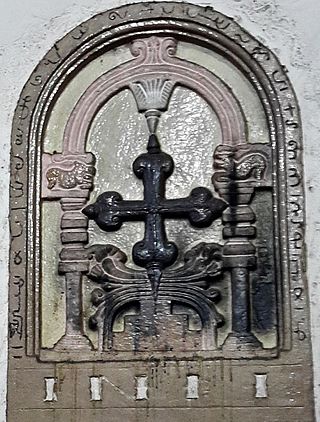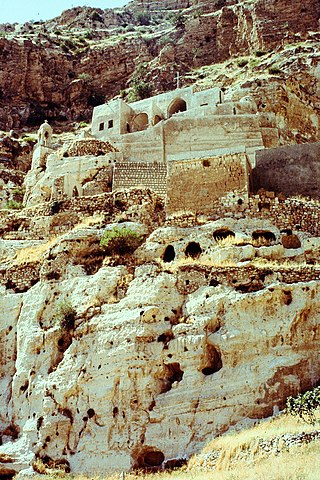
The Assyrian Church of the East (ACOE), sometimes called Church of the East, officially the Holy Apostolic Catholic Assyrian Church of the East, is an Eastern Christian church that follows the traditional Christology and ecclesiology of the historical Church of the East. It belongs to the eastern branch of Syriac Christianity, and employs the Divine Liturgy of Saints Addai and Mari belonging to the East Syriac Rite. Its main liturgical language is Classical Syriac, a dialect of Eastern Aramaic, and the majority of its adherents are ethnic Assyrians.

Mar Shimun XIX Benyamin served as the 117th Catholicos-Patriarch of the Church of the East.

Qudshanis, "Kochanis" or "Kochanes", is a small village in the Hakkâri District of Hakkâri Province, Turkey. The village is populated by Kurds of the Pinyanişî tribe and population was 19 in 2021.

Mar Dinkha IV, born Dinkha Khanania was an Eastern Christian prelate who served as the 120th Catholicos-Patriarch of the Assyrian Church of the East. He was born in the village of Darbandokeh (Derbendoki), Iraq and led the Church in exile in Chicago for most of his life.

The Chaldean Syrian Church of India is an Eastern Christian denomination, based in Thrissur, in India. It is organized as a metropolitan province of the Assyrian Church of the East, and represents traditional Christian communities of the East Syriac Rite along the Malabar Coast of India. It is headed by Mar Awgin Kuriakose.

Mar Shimun XX Paulos served as the 118th Catholicos-Patriarch of the Assyrian Church of the East.

Mar Shimun XVII Abraham served as the Catholicos-Patriarch of the Assyrian Church of the East from c. 1820 to 1861.

The Church of the East or the East Syriac Church, also called the Church of Seleucia-Ctesiphon, the Persian Church, the Assyrian Church, the Babylonian Church or the Nestorian Church, was an Eastern Christian church of the East Syriac Rite, based in Mesopotamia. It was one of three major branches of Eastern Christianity that arose from the Christological controversies of the 5th and 6th centuries, alongside the Oriental Orthodox Churches and the Chalcedonian Church. During the early modern period, a series of schisms gave rise to rival patriarchates, sometimes two, sometimes three. Since the latter half of the 20th century, three churches in Iraq claim the heritage of the Church of the East. Meanwhile, the East Syriac churches in India claim the heritage of the Church of the East in India.

The Patriarch of the Church of the East is the patriarch, or leader and head bishop of the Church of the East. The position dates to the early centuries of Christianity within the Sassanid Empire, and the Church has been known by a variety of names, including the Church of the East, Nestorian Church, the Persian Church, the Sassanid Church, or East Syrian.

Mar Shemʿon VII Ishoʿyahb, born Īshōʿyahb bar Māmā, was Patriarch of the Church of the East from 1539 to 1558, with residence in Rabban Hormizd Monastery.

Mar Eshai Shimun XXIII, sometimes known as Mar Eshai Shimun XXI, Mar Shimun XXIII Ishaya, Mar Shimun Ishai, or Simon Jesse, served as the 119th Catholicos-Patriarch of the Assyrian Church of the East from 1920, when he was a youth, until his murder on 6 November 1975.
Shimun Yahballaha, also designated in some modern historiographical works as Yahballaha IV, or even Yahballaha V, was Patriarch of the pro-Catholic line of primates of the Church of the East, from c. 1572 to c. 1580. In primary sources, he is mentioned as patriarch Shimun by several inscriptions dated from 1572 to 1577, while his additional name Yahballaha is recorded in a later report, submitted to Rome (1581) by metropolitan Eliya. The same report describes recently deceased patriarch Yahballaha Shimun as an elderly hierarch, who was elected to the patriarchal see sometime after the death of Abdisho IV Maron, but did not seek confirmation from Rome, due to his advanced age.
Shimun X was Patriarch of the Shemʿon line of primates of the Church of the East, from c. 1600 to c. 1638. He is claimed both by the Chaldean Catholic Church and the Assyrian Church of the East. Upon accession to the patriarchal throne, he moved his seat from Urmia to Salmas, and also resided in Khananis near Qodshanis. He succeeded Patriarch Shimun IX Dinkha who was in full communion with the Catholic Church. Unlike his predecessor, who was officially recognized by Rome as the Patriarch of the Chaldeans, Shimun X was not formally recognized by the Catholic Church because his election was based on hereditary principle, reintroduced after the death of his predecessor. Hereditary succession was considered an unacceptable practice by the Rome. In 1616, contacts between patriarch Shimun X and the Catholic Church were initiated, upon arrival of Catholic missionaries to the region. Patriarch composed a profession of faith, that was sent to Rome for assessment. Upon examination, Shimun′s profession was found inadequate, and he was not received into communion with the Catholic Church. Similar attempt was made in 1619, but wit no final conclusion. Because of such complex situation, his legacy was viewed differently along denominational lines, and claimed by both sides. He is considered as pro-Catholic by the Chaldean Catholic Church, and also as non-Catholic by the Assyrian Church of the East.
Mar Shimun XVI Yohannan was Patriarch of the Shem'on line (Qodshanis) of the Church of the East, from 1780. In 1804, he became the sole Patriarch among traditionalist Christians of the East Syriac Rite, because the rival Patriarch Eliya XII (1778-1804) of the Eliya line died without successor. Shimun XVI remained patriarch until his death in 1820.

Eliya VI was Patriarch of the Church of the East from 1558 to 1591, with residence in Rabban Hormizd Monastery, near Alqosh, in modern Iraq. In older historiography, he was designated as Eliya VI, but later renumbered as Eliya "VII" by some authors, who believed that during the period from 1558 to 1591 there were two successive Eliya patriarchs. After the resolution of several chronological questions, he was designated again as Eliya VI, and that numeration is accepted in recent scholarly works.
Mar Shemʿon II was the patriarch of the Church of the East from c. 1385 until c. 1405. He succeeded Denha II, who died in 1381/2, and his reign corresponds to the beginning of a period of obscurity in the Church of the East and the patriarchal succession.

Eliya XII was Patriarch of the Church of the East, from 1778 to 1804, with formal residence in Rabban Hormizd Monastery, near Alqosh, in modern Iraq. His birth name was Ishoyahb, and he was the elder son of priest Abraham, who was brother of the previous patriarch Eliya XI (1722-1778). In 1744, Ishoyahb was consecrated as metropolitan, and designated as presumptive successor by his paternal uncle, patriarch Eliya XI, who died in 1778, and Ishoyahb succeeded him, as patriarch Eliya XII. His tenure was marked by a prolonged rivalry with his pro-Catholic cousin Yohannan Hormizd, who also claimed the patriarchal throne. In 1804, Eliya XII died and was buried in the Rabban Hormizd Monastery, as the last patriarch of the senior Eliya line.
Mar Shemʿon VI was Patriarch of the Church of the East from 1504 until his death on 5 August 1538. Shemon is credited with revising the East Syriac Rite, replacing commemorations of traditional saints and martyrs with new ones, especially for those who had founded monasteries. Following his death, he was succeeded as Patriarch by his brother Shemon VII Ishoyahb, who had been natar kursya throughout his reign; since the reign of Shemon IV the role of Patriarch had been passed hereditarily. Shemon VI was buried alongside other Patriarchs of his era at Rabban Hormizd Monastery near Mosul, his residence while he had been Patriarch; his epitaph, recorded by Vosté, was inscribed by a priest named Israel.












